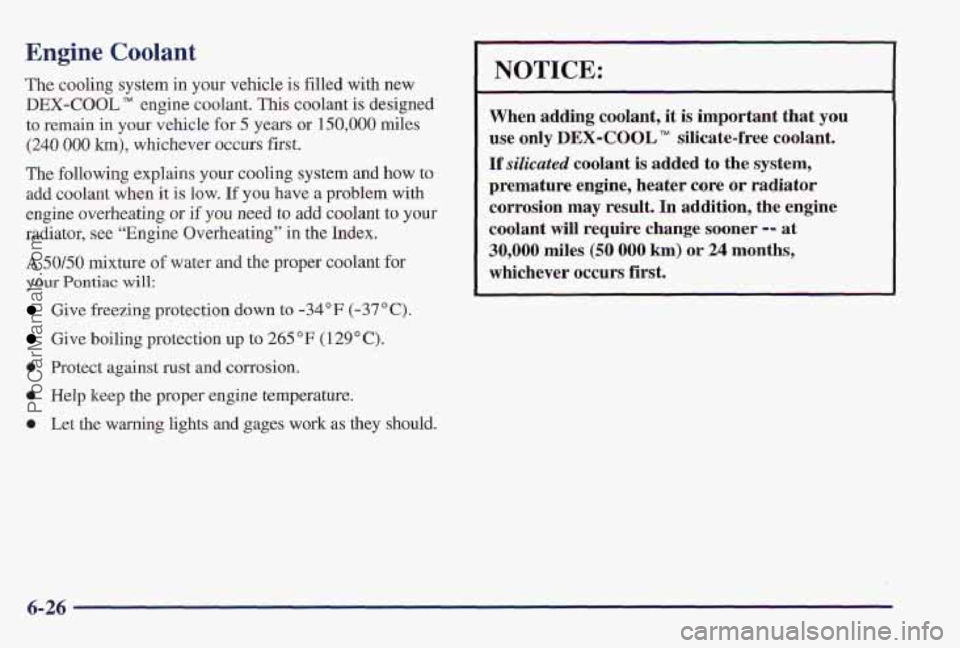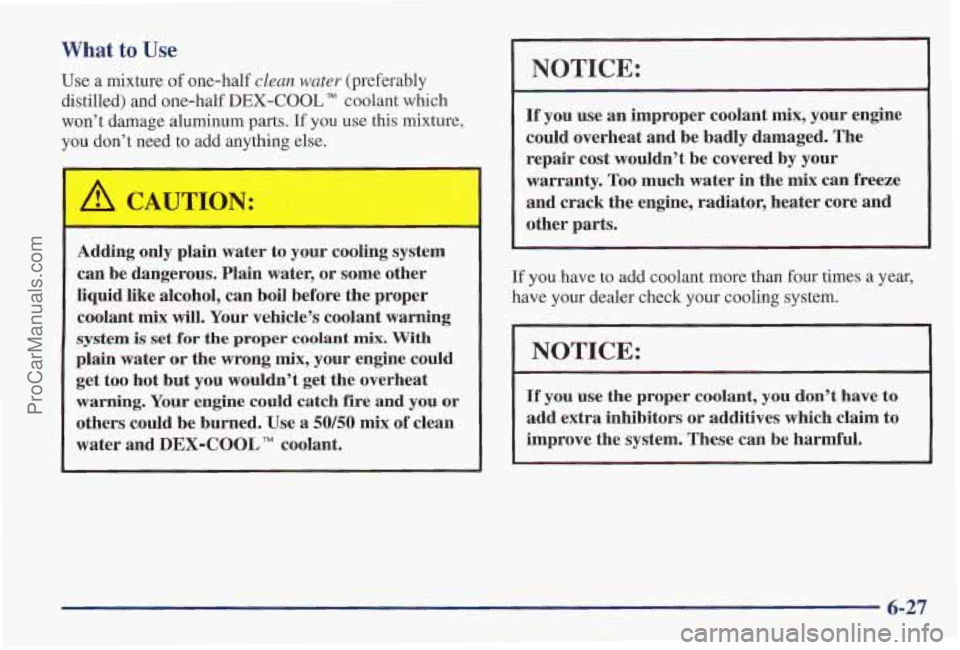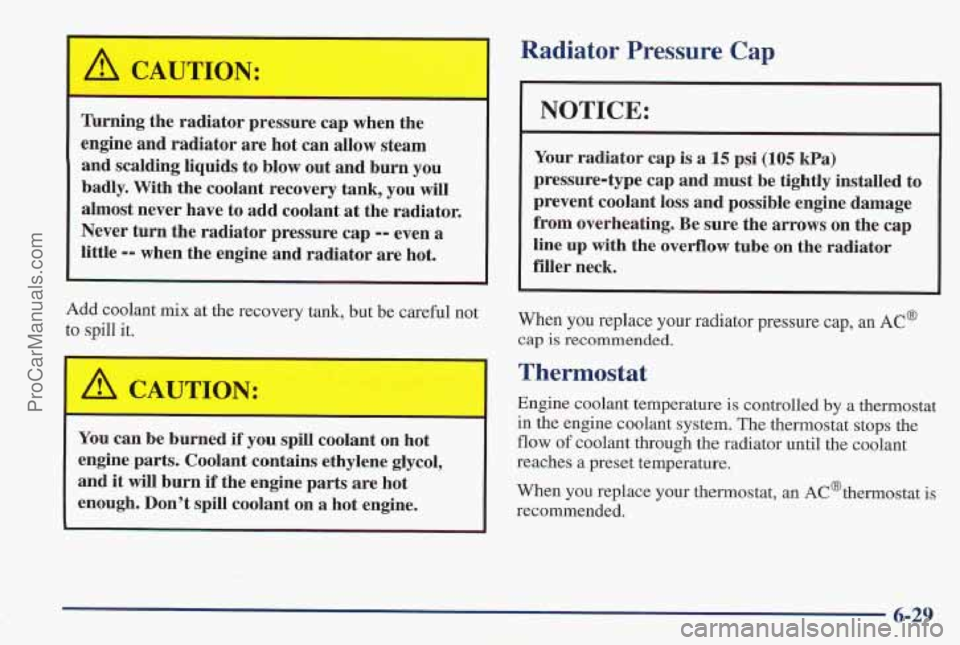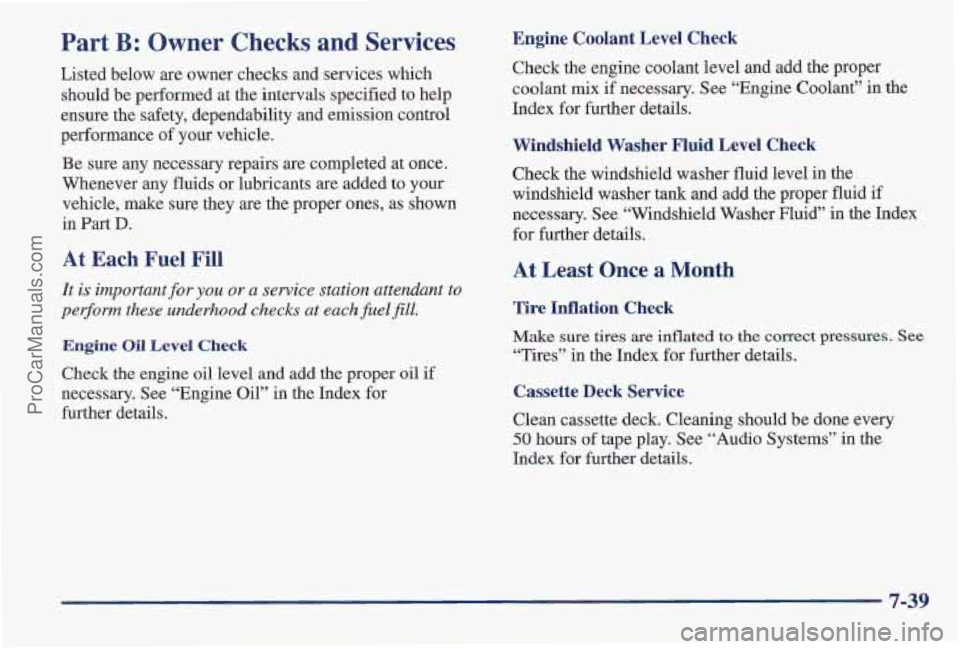Page 281 of 419
When you open the hood of the 3800 Supercharged engine, you'll see:
- : I: .,,
A. Windshield Washer Fluid
B. Radiator Fill Cap
C. Remote Positive Battery Terminal
D. Power Steering Fluid Reservoir
E. Engine Oil Dipstick F,
Engine Oil Fill Cap
G. Automatic Transaxle Dipstick
H. Brake Fluid Reservoir
I. Engine Coolant Reservoir
J. Air Cleaner
6-11
ProCarManuals.com
Page 296 of 419

The cooling system in your vehicle is filled with new
DEX-COOL TM engine coolant. This coolant is designed
to remain in your vehicle for 5 years or 150,000 miles
‘(240 000 h), whichever occurs first.
The following explains your cooling system and how to
add coolant when it is low. If you have a problem with
engine overheating or if you need to add coolant to your
radiator, see “Engine Overheating” in the Index.
A $OB0 mixture of water and the proper coolant for
your Pontiac will:
Give freezing protection down to -34°F (-37°C).
Give boiling protection up to 265 “F (129’ C).
0 Protect against rust and corrosion.
0 Help keep the proper engine temperature.
0 Let the warning lights and gages work as they should.
I
NOTICE:
When adding coolant, it is important that you
use only IBEX-COOL TM silicate-free coolant.
If silicated coolant is added to the system,
premature
engine, heater core or radiator
corrosion may result. In addition, the engine
coolant
will requipe change sooner -- at
30,000 miles (50 000 km) or 24 months,
whichever occurs first.
6-26
ProCarManuals.com
Page 297 of 419

What to Use
Use a mixture of one-half clean water (preferably
distilled) and one-half
DEX-COOL TM coolant which
won’t damage aluminum parts.
If you use this mixture,
you don’t need to add anything else.
Adding only plain water to your cooling system can be dangerous. Plain water, or some other
liquid like alcohol, can boil before the proper
coolant mix will. Your vehicle’s coolant warning
system
is set for the proper coolant mix. With
plain water or the wrong mix, your engine could
get too hot but you wouldn’t get the overheat
warning. Your engine could catch fire and you or
others could be burned. Use
a 50/50 mix of clean
water and
DEX-COOL TM coolant.
NOTICE:
If you use an improper coolant mix, your engine
could overheat and be badly damaged. The
repair cost wouldn’t be covered by your
warranty.
Too much water in the mix can freeze
and crack the engine, radiator, heater core and
other parts.
If you have to add coolant more than four times a year,
have your dealer check your cooling system.
~~
NOTICE:
If you use the proper coolant, you don’t have to
add extra inhibitors or additives which claim to
improve the system. These can be harmful.
6-27
ProCarManuals.com
Page 298 of 419
Checking Coolant
When your engine is cold, the coolant level should be
at the COLD mark or a little higher. To check coolant
level, remove the cap on the coolant recovery bottle and
verify that
the coolant level is up to the COLD fill level
on the hose attached to the cap.
LOW
COOLANT
If this light comes on, it
means
you’re low on
engine coolant.
Adding Coolant
If you need more coolant, add the proper DEX-COOL”
coolant mixture at the mulant recovery tank.
If the coolant recovery tank is completely empty, add
coolant
to the radiator. (See “Engine Overheating” in
the
Index.)
6-28
ProCarManuals.com
Page 299 of 419

Turning the radiator pressure cap when the
engine and radiator
are hot can allow steam
and scalding liquids to blow out and burn
you
badly. With the coolant recovery tank, you will
almost never have to add coolant at the radiator.
Never turn the radiator pressure cap
-- even a
little -- when the engine and radiator are hot.
Add coolant mix at the recovery tank, but be careful not
to spill it.
You can be burned if you spill coolant on hot
engine parts. Coolant contains ethylene glycol,
and it will burn
if the engine parts are hot
enough. Don't spill coolant on a hot engine.
I I
Radiator Pressure Cap
NOTICE:
Your radiator cap is a 15 psi (105 kPa)
pressure-type cap and must be tightly installed to
prevent coolant loss and possible engine damage
from overheating. Be sure the
arrows on the cap
line up with the overflow tube
on the radiator
filler neck.
When you replace your radiator pressure cap, an AC'
cap is recommended.
Thermostat
Engine coolant temperature is controlled by a thermostat
in
the engine coolant system. The thermostat stops the
flow of coolant through the radiator until the coolant
reaches a preset temperature.
When
you replace your thermostat, an AC@thermostat is
recommended.
6-29
ProCarManuals.com
Page 371 of 419
I Short Trip/City Maintenance Schedule I
- In hi
- Whe lly or mountainous terrain.
:n doing frequent trailer towing.
- Uses such as found in taxi, police or
delivery service.
If you do not use your vehicle under any of
these conditions, the fluid andfilter do not
require
changing.
150,000 Miles .(240 000 km)
CI Drain, flush and refill cooling system
(or every 60 months since last service,
whichever occurs
first). See “Engine
Coolant’’
in the Index for what to use.
Inspect hoses. Clean radiator, condenser,
pressure cap and neck. Pressure test cooling
system and pressure cap.
An Emission Control Sewice.
I DATE I ACTUAL MILEAGE ISERVICED BY: I
7-27
ProCarManuals.com
Page 382 of 419
Long Trip/Highway Maintenance Schedule
100,000 Miles (166 000 km) (Continued)
- In hilly or mountainous terrain,
- When doing frequent trailer towing.
- Uses such as found in taxi, police or
lfyou do not use your vehicle under any of
these conditions, the fluid aadJi’lter do not
require changing.
delivery service.
*
150,000 Miles (240 000 km)
0 Drain, flush and refill cooling system
(or every 60 months since last service,
whichever occurs first). See “Engine
Coolant” in the Index for what to use.
Inspect hoses. Clean radiator, condenser,
pressure cap and
neck. Pressure test the
cololing system
and pressure cap.
An Emission Control Service.
DATE ACTUAL MILEAGE SERVICED BY: -
7-38
ProCarManuals.com
Page 383 of 419

Part B: Owner Checks and Services
Listed below are owner checks and services which
should be performed at the intervals specified to help
ensure the safety, dependability and emission control
performance
of your vehicle.
Be sure any necessary repairs are completed at once.
Whenever any fluids or lubricants are added to your
vehicle, make sure they are the proper ones, as shown
in Part
D.
At Each Fuel Fill
It is important for you or a service station attendant to
perform these underhood checks at each fuel
fill.
Engine Oil Level Check
Check the engine oil level and add the proper oil if
necessary. See “Engine Oil” in the Index for
further details.
Engine Coolant Level Check
Check the engine coolant level and add the proper
coolant mix if necessary. See “Engine Coolant” in the
Index for further details.
Windshield Washer Fluid Level Check
Check the windshield washer fluid level in the windshield washer tank and add the proper fluid if
necessary. See “Windshield Washer Fluid” in
the Index
for further details.
At Least Once a Month
Tire Inflation Check
Make sure tires are inflated to the correct pressures. See
“Tires” in the Index for further details.
Cassette Deck Service
Clean cassette deck. Cleaning should be done every
50 hours of tape play. See “Audio Systems” in the
Index for further details.
7-39
ProCarManuals.com